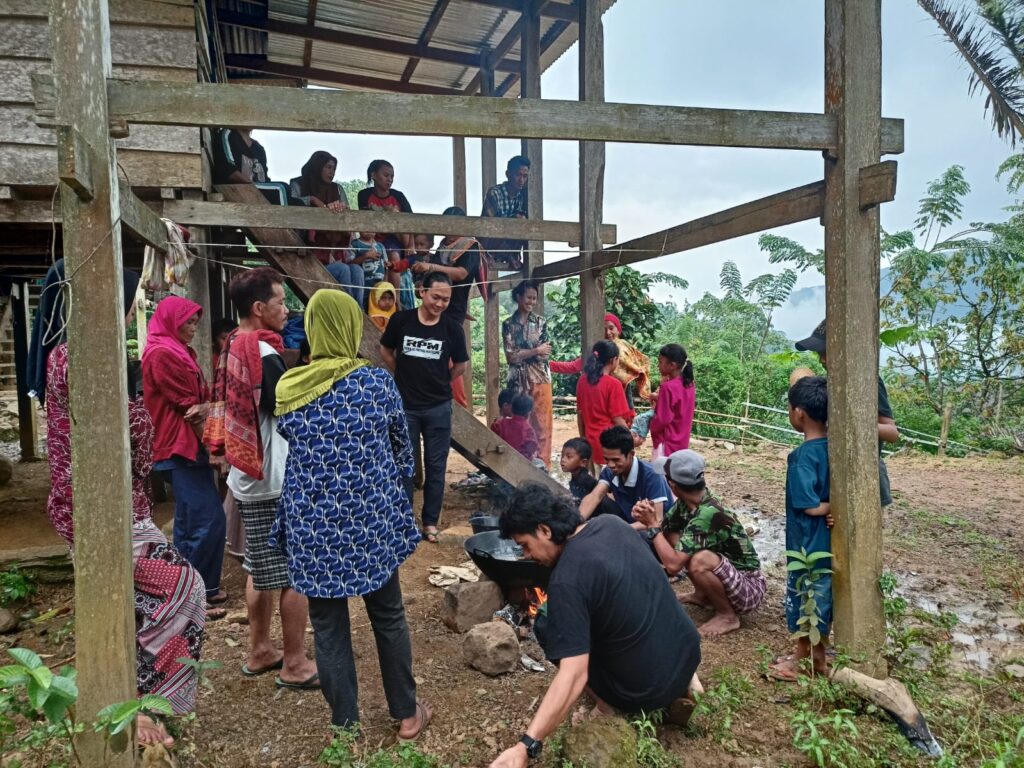The ant sugar processing training took place in Cindakko hamlet with the Cindakko Hill Women's Farmers Group (KWT); Tuesday 16 May 2023. At a high point, on one of the series of Cindakko hills, Maros district; The Cindakko indigenous people call it Kacoci. At that point our goal, (me, Alfat and Kak Enal) was to walk for one hour from the motorbike stop, to Pak Indar's house.
We, arrived at 10 am. Passing the steep path that we often call the "climb of love." Those who are not used to walking while climbing, will feel the contents of their stomach coming out, yellow vomit, blurred vision, and that is the definition of love on the climb.
Mr. Indar, husband of the chairman of KWT Bukit Cindakko, welcomed us in the middle of the climb, one kilometer to the location. At that time Mr. Indar was looking for a network on a terraced rice field embankment. Mr. Indar intended to contact us, he was already worried, because we hadn't arrived yet, even though our appointment was supposed to be one day ago.
Pak Indar shouted from above, we looked up, and he greeted us with a smile.
Together with Mr. Indar, we talked about the sugar ant training plan that we had agreed on. Mr Indar smiled, we flirted; the sugar ant training had to be carried out that very day, and it was Mr Indar who we relied on to make the training event a success. Mr Indar agreed to our request. Mr. Indar went to inform the Kacoci residents to gather at 14:00, and we continued our journey to Mr. Indar's house.
At Mr. Indar's house, we were warmly welcomed by Mrs. Indar, head of KWT Bukit Cindakko. He gave us cold and refreshing water. The journey to Kacoci could be said to be a journey that drains your throat of saliva. It feels really nice to drink refreshing mountain water when you are tired and breathless.
After that, Mr. Indar joined in, and brought the good news, that the KWT members had agreed to take the sugar ant training time.
At 14:00, palm juice was already erupting on the burning pan, under the wooden stilt house. The KWT members gathered around the wok. KWT members talked and discussed after hearing a brief explanation from the resource person about the ant sugar processing process.
It's just that, after the Nira water starts to darken, the Nira water cannot powder into ant sugar. The sap solution used as the main ingredient for making ant sugar turns out to be old and has gone through a fermentation process.
However, this failure did not dampen the enthusiasm of the mothers, KWT members. We agreed to buy new sap water, and start over from the beginning.
While waiting for the new palm juice to be poured into the pan, the training continues with coffee production.
Sis Enal as the resource person explained in quite detail. Enal's explanations were also not complicated, so that the process of transferring knowledge about coffee to smallholder farmers was smooth and easy to understand.
Look at one of the coffee farmers, Mr. Nawir who is very enthusiastic, giving input by sharing his experience about the difficulties of caring for coffee trees. According to Mr. Nawir, he was very, very grateful to take part in the training event, because he gained new knowledge about how to care for coffee trees.
Pak Nawir also explained that his biggest challenge as a coffee farmer is laziness. In fact, according to him, after following the explanation from the resource person, caring for coffee from planting to post-harvest requires commitment and patience.
After the coffee production training discussion process, the participants moved back to the pan of palm sugar which was boiling under the house. It was approaching sunset, the mothers gathered again and really hoped that this practice would be successful.
Seeing that the palm juice had not turned into powder, the mothers began to feel overwhelmed and wanted to give up. However, they decided to continue stirring until the Nira started to cool. The result of joint efforts and never giving up, the doubtful Nira water eventually pollinated and became ant sugar.
In the post-stirring process of ant sugar, the mothers have a unique way of sifting the ant sugar; they replaced the sieving process with a screening process; Ant sugar is treated like a rice sieve process. This unique process turns out to be easier and more efficient. Coarse and fine ant sugar separate very quickly.
During the process of wrapping the ant sugar, the women, KWT members, were very grateful that their practice was successful and of fairly good quality.


